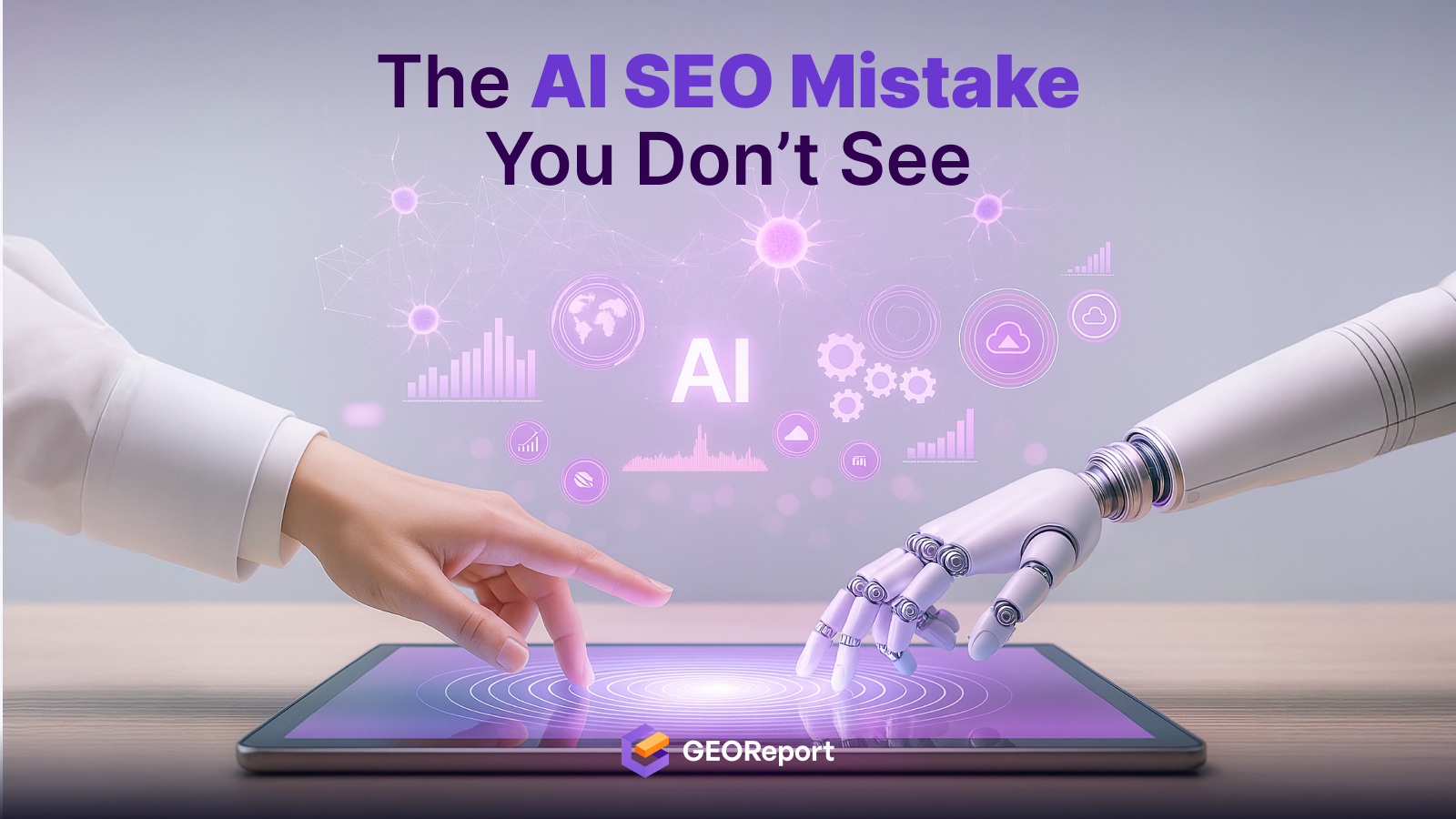3 Signs Your AI SEO Strategy Is Actually Hurting Visibility

The AI SEO boom has made it easier than ever to publish content fast but also easier to disappear from AI search entirely. Most brands believe they are optimizing for visibility when they are actually training generative engines not to trust them.
If your content is repetitive, inconsistent, or poorly structured, ChatGPT, Gemini, and Claude will quietly filter you out of their reasoning layer. Understanding these silent red flags and fixing them through Generative Engine Optimization (GEO) is the key to building visibility that lasts.
When More Content Starts Working Against You
Marketers love scale. With new tools that automate outlines, generate posts, and rewrite articles in seconds, publishing velocity has exploded. But here’s the irony: the faster your team produces AI-generated content, the faster your AI SEO visibility can collapse.

Generative engines do not reward quantity. They reward clarity, evidence, and semantic diversity. When you publish hundreds of near-identical posts optimized for the same keyword cluster, models compress them into one diluted node inside their reasoning graph. Your content does not get stronger; it gets blurred.
This is what GEOReport.ai calls Visibility Collapse, a phenomenon where excessive automation floods AI systems with repetitive phrasing and low factual density. The model recognizes your domain but gradually reduces your weight in reasoning results.
Traditional SEO metrics like traffic, clicks, and keyword ranks will not show this decay. You might see stable numbers in Google Search Console while your Generative Engine Optimization metrics (like VDI and ECS) quietly erode.
By the time you notice, ChatGPT has already stopped mentioning you.
Let’s unpack the three major signs your AI SEO strategy is doing more harm than good.
Sign 1: You Are Producing AI Content Without an AI Content Strategy
Publishing with AI is not the problem. Publishing without reasoning intent is.
When teams use generative tools to mass-produce “What is X?” style posts, they create surface content that adds no reasoning value. AI systems do not need definitions; they need understanding. If your pages do not teach why or how, they fail the model’s logic test.
Consider two articles about “AI marketing automation.” One lists features and definitions. The other explains how automation changes campaign structure, cites real data, and shows measurable outcomes. Both are optimized for SEO, but only one passes AI comprehension filters.
This is where an AI content strategy separates amateurs from leaders. A good strategy defines your reasoning footprint, the unique logic your brand contributes to the market conversation. Instead of asking, “What keyword should we target?”, you ask, “What reasoning gap can we fill that AI models will reuse?”
Without this clarity, your site becomes a content mill with zero AI trust. Generative models treat it like background noise: present, but irrelevant.
Fix: Start building around reasoning depth instead of keyword depth. Before publishing, ask: “If ChatGPT generated an answer tomorrow, would this paragraph help it explain something better?” That is the new test of value in AI SEO.
Sign 2: You Are Measuring Keywords Instead of Reasoning Visibility
The biggest blind spot in modern SEO is still measurement. Tools like Ahrefs and Semrush remain valuable, but they only show visibility in Google, not in generative reasoning systems. Marketers often celebrate keyword gains while their AI visibility quietly vanishes.
Generative engines do not rank pages; they recall reasoning patterns. If your content appears on the web but not inside AI-generated responses, you are invisible where it matters most.
This is why Generative Engine Optimization introduces a new set of metrics built for the AI layer.
- Visibility Depth Index (VDI): measures how deeply your content influences AI reasoning.
- Entity Confidence Stability (ECS): shows whether AI models consistently trust your brand’s facts.
- Reasoning Depth Ratio (RDR): tracks how often your content supports logical explanations, not surface mentions.
Most AI SEO strategies fail because they never track these. They rely on impressions and backlinks, numbers that look impressive but mean nothing to an AI model.
Fix: Adopt dual analytics. Keep your SEO dashboards for search metrics, but add a GEO layer for reasoning metrics. When your SEO report says “ranked number one,” ask your GEO report, “but is AI using it?” If the answer is no, you are optimizing for humans but losing machines.
Sign 3: You Are Optimizing for Traffic Instead of Trust
Traffic is a vanity metric in the AI era. AI does not care how many visitors you have; it cares how many facts you can prove. A page that brings in ten thousand visitors means nothing if the AI sees contradictions or unreliable data inside it.

In generative reasoning, trust is visibility. Every time AI finds a mismatch between your claims, schema, or tone, it lowers your entity confidence score. Do this enough times, and your domain becomes a low-trust node.
This happens most often when teams chase topical trends without maintaining consistency. They publish on multiple subtopics, each using slightly different brand facts, metrics, or definitions. Humans will not notice, but AI will. The inconsistency tells the model, “This brand is uncertain,” so it prioritizes others.
Even something as simple as differing product names or mismatched leadership titles across pages can break your Entity Confidence Stability (ECS). Generative engines use schema and factual context to verify you. When that context wobbles, your entire reasoning footprint collapses.
The solution is discipline. You need a factual source of truth and schema that stays synchronized with it. Every page update should pass through a GEO audit, a process that checks logic consistency, factual stability, and evidence presence.
AI visibility is no longer about reach; it is about reliability. In the new SEO AI world, trust beats traffic every time.
Why Generative Engine Optimization Is the Fix
Most AI SEO problems come from treating content as text instead of data. Generative Engine Optimization treats it as reasoning data, a structure that machines can follow, interpret, and reuse.
When you align your AI content strategy with GEO principles, three shifts happen.
First, your pages stop chasing keywords and start answering reasoning gaps. Second, your analytics shift from page views to reasoning metrics. Third, your content stops flooding the web and starts building AI memory.
That is how visibility works now. Generative engines do not reward noise; they reward structure, evidence, and coherence.
Brands that embrace GEO are not just optimizing for search; they are building long-term interpretability. They are turning their content into training-grade material that AI models trust enough to quote. And that is the ultimate visibility signal.
FAQs
Q1: Why can AI-generated content hurt visibility?
A1: Because most AI content lacks reasoning depth and factual consistency. Models filter it as redundant noise instead of reliable knowledge.
Q2: How do I know if my AI SEO strategy is working?
A2: If ChatGPT, Gemini, or Claude consistently recall your brand in relevant answers, your reasoning visibility is growing. GEO metrics like VDI and ECS confirm it.
Q3: Does Generative Engine Optimization replace traditional SEO?
A3: No. GEO builds on SEO. It optimizes your content for both human searchers and AI reasoning systems.
Q4: What is the first step to fixing a weak AI SEO strategy?
A4: Start by auditing your site with GEOReport.ai to identify structural and factual gaps that prevent AI from reusing your content.
Editor’s Note
Every marketer says they want AI visibility but few realize their own strategy is what is hiding them. Fast publishing, keyword chasing, and inconsistent structure might win clicks today but lose reasoning trust tomorrow.
If you want to stay visible in generative search, slow down, structure better, and think like a model. AI SEO gets you found. Generative Engine Optimization makes you understood. And in the era of ChatGPT and Gemini, only the understood survive.
